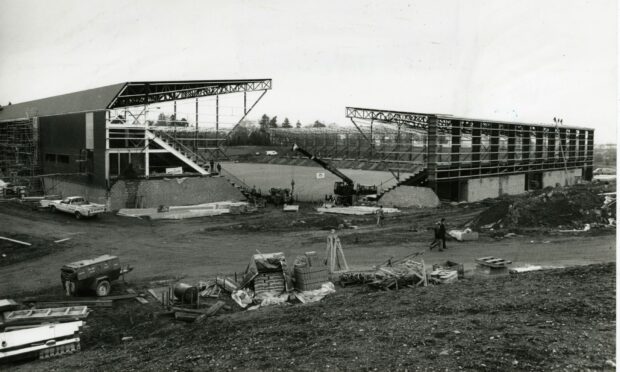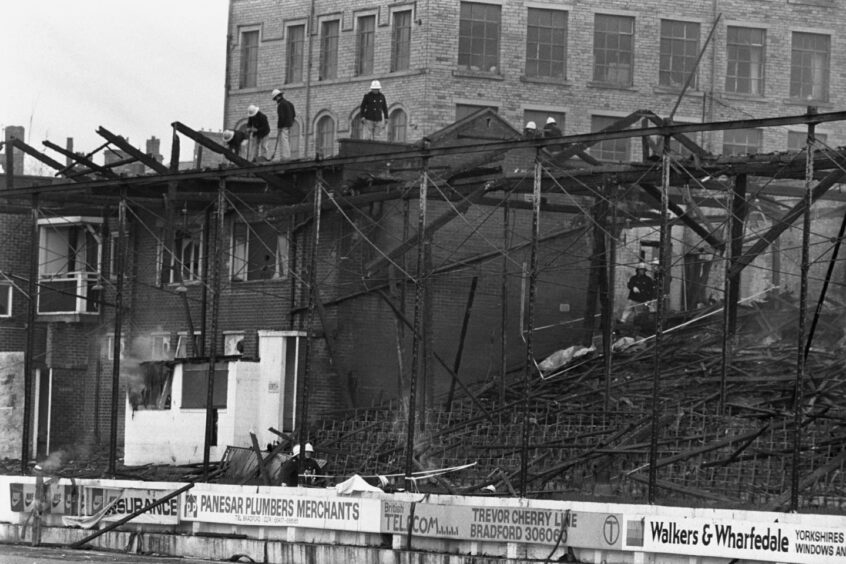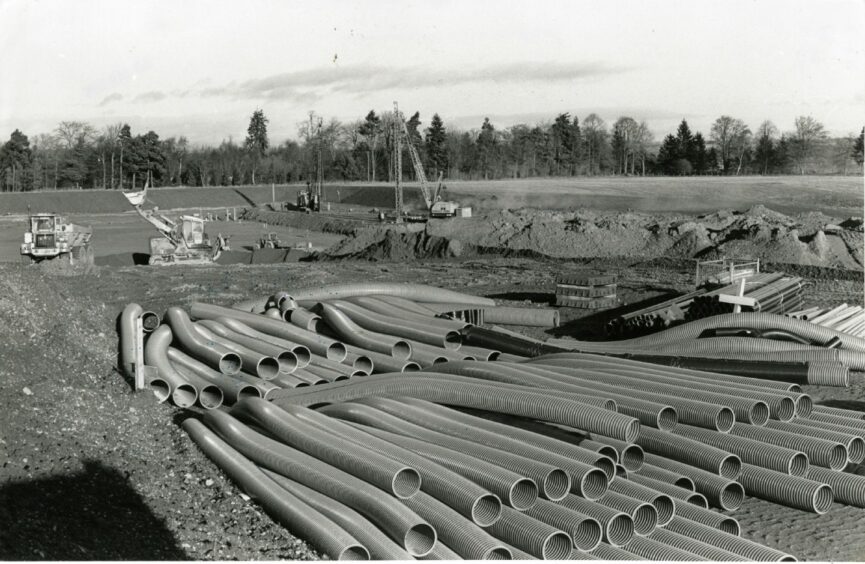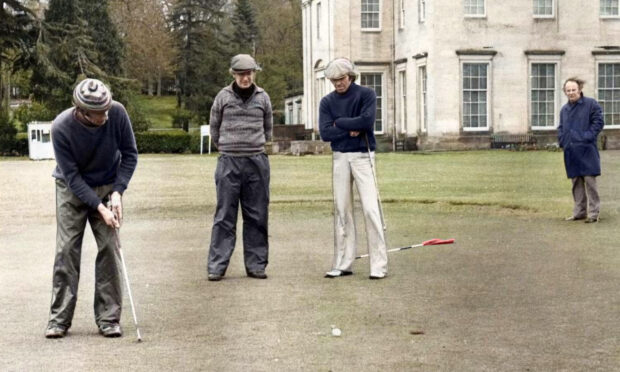It was a disaster that started in the midst of sporting cheers and celebrations and ended with hundreds of people being killed or injured.
Bradford City fans had been in positive voice when the club received the Third Division trophy, prior to their meeting with Lincoln City, on May 11 1985.
But the sense of triumph among the supporters turned to panic, shortly before 3.45pm, when a fire rapidly swept through the rickety old wooden seats inside Valley Parade.
The ensuing conflagration claimed the lives of 56 spectators and injured more than 250 other fans.
Many were burned to death at the turnstiles gates, which had also been locked after the match had begun.
There were many cases of heroism, with more than 50 people later receiving police awards or commendations for bravery.
But the appalling events were the catalyst for the transformation of many clubs across Britain, whose custodians recognised that their grounds were no longer fit for purpose – and St Johnstone led the way in ditching their dated, dangerous facilities and moving forward with a new plan for the future.
The process started 35 years ago this month when the Perth club – which was languishing in the doldrums with crowds numbering in the 100s rather than 1,000s – took the initial steps in plotting a path away from their old home at Muirton Park to a new state of the art stadium at McDiarmid Park.
And there wasn’t any opposition to the plans after the Bradford carnage exposed the reality that too many clubs were stuck with Victorian amenities.
There would, of course, be another hellish disaster in British football – at Hillsborough in 1989, which killed 96 Liverpool supporters – although that was not directly related to the infrastructure inside the ground.
But, just four months later, St Johnstone hanselled McDiarmid Park, Britain’s first purpose-built all-seater stadium, with a capacity of 10,696.
Some other organisations had responded to the Bradford inferno by replacing their old seats with newer equivalents, but they were merely papering over the cracks and not making a move away from wooden accommodation for fans.
However, McDiarmid Park set the trend that everybody else followed across the UK and Lord Taylor even came to inspect it as part of his report.
The venue contained four fully-covered stands, next to a site with parking for up to 1,000 cars and 100 coaches, in addition to a synthetic surface that was designated as a training ground: facilities which might be taken for granted at many leading clubs today but were genuinely revolutionary 30 years ago.
The move was partly born of necessity and driven by the vision and business acumen of St Johnstone’s then-chairman, Geoff Brown, who recognised that dramatic changes had to be implemented in the Fair City.
The stadium had existed since 1924 and been the setting for a string of memorable performances by generations of Saints, both in domestic action and on the few occasions when they launched forays into Europe.
Farewell, Muirton Park
Yet, by the ’80s, it wasn’t so much dilapidated as decrepit and some of the wooden seats were taped off by stewards on match days.
Not that there was anybody clamouring to use them at a club that was in seriously dire straits and teetering on the brink of oblivion, on and off the park.
Therefore, it was was with a sense of relief that an agreement was struck that would not only guarantee survival but offer them a fresh start.
The Press & Journal reported on December 30 1986: “St Johnstone have been approached by a multi-national company, who want to turn Muirton Park and the adjoining ice rink into a superstore.
“As part of the deal, the club would be rehoused in a 10,000 all-seated, multi-purpose stadium. The club have a bank overdraft of £200,000 with running costs of £3,500 a week.”
Nothing was easy in the months ahead.
Lengthy negotiations followed with several deals almost falling through on a number of occasions before an agreement was eventually struck that would see Asda foot the bill of just over £4 million to create a new stadium for Saints and, in return, they would use Muirton Park as the site of their major new retail outlet.
Shortly afterwards, a prescient local farmer named Bruce McDiarmid donated 16 acres of his land, not to the club, but to the people of Perth.
The construction costs were £4.9 million, which was a massive sum for a team languishing in Scotland’s second tier at the time of these developments.
Within the next two years, however, McDiarmid Park was duly brought to fruition and a resurgent St Johnstone started attracting crowds of 8,000 and 9,000 fans; an attendance that contrasted starkly with the paltry crowd of 466 who had turned up to watch the Saints against Albion Rovers in the mid-80s.
Nonetheless, there were still many aficionados who were determined to bid farewell to Muirton Park when it staged its final match on April 29 1989.
It might only have been a faded relic of its former glory but the old ground was given a rousing send-off by supporters, even if there was no last hurrah.
Instead, the 1,227th competitive game at the stadium saw Ayr United edging their way to a 1-0 victory with former St Johnstone player John Sludden becoming the last-ever goal scorer at the venue.
And then it was off to pastures new.
And, soon enough came the opportunity for the Perth club to lock horns with Alex Ferguson’s Manchester United.
The arrival of the Old Trafford squad highlighted how much had changed in the switch between Muirton and McDiarmid.
During their history, the club had been forced to endure numerous financial crises, none more so than in the mid-80s.
In the 1985-1986 campaign, they finished 30th out of Scotland’s 38 clubs, a dismal performance that equalled that of 1952-53, which was the worst in their post-war history.
Fewer than 23,000 diehards turned up for the 23 home fixtures and match attendances of under 1,000 became a commonplace occurrence.
The annual accounts turned into an exercise of damage limitation on the way towards oblivion.
In which light, one can understand the joyous scenes on August 19 1989 when the hosts arrived at their new stadium – and defeated Clydebank 2-1 in the inaugural match at the refulgent ground.
There was understandable pride among St Johnstone’s staff and supporters when Ferguson – one of their former players – brought a star-studded Man Utd line-up, including the likes of Jim Leighton, Steve Bruce, Mark Hughes, Gary Pallister, Paul Ince and Brian McClair to Perth on October 17.
The attendance was almost 10,000 for the midweek fixture, and although the occasion was slightly tarnished by a 21-minute stoppage due to floodlight failure, the hosts acquitted themselves well against their illustrious rivals.
The Courier reported: “After the presentation of the players to dignitaries such as Sir Matt Busby and Bobby Charlton, and a fireworks display which came close to injuring the unsuspecting Leighton, the game kicked off.
“The fact that Manchester United’s starting line-up cost more than double the construction of the entire McDiarmid Park complex spoke for itself, but it was the Scottish First Division leaders who created the early opportunities.
“Saints can take great credit from the fact that, during the first hour, they dominated proceedings and carved out a handful of clear chances.
“But a goal from Brian McClair (in the 62nd minute), coming after a bad error by Alan McKillop, seemed to knock the stuffing out of the Perth side.
“At the end, both sides were given a great reception by the near capacity crowd after what had been, at the very least, an unusual night.”
The unexpected black-out was given a story of its own in The Courier, which reported that it had been caused by a failure at a nearby substation and had nothing to do with the lights themselves.
But even though “worried police officers broadcast appeals to the crowd to remain seated”, an electrician from the Hydro Board attended the stadium and, within minutes of his arrival, full lighting had been restored.”
Nothing was going to take the gloss off the occasion. And, ever since, McDiarmid Park has hosted football and rugby matches and been the setting for pop concerts by such superstars as Sir Elton John and Lionel Richie.
Not bad for an idea that was conceived in the aftermath of terrible tragedy by a club hitting the skids.


















